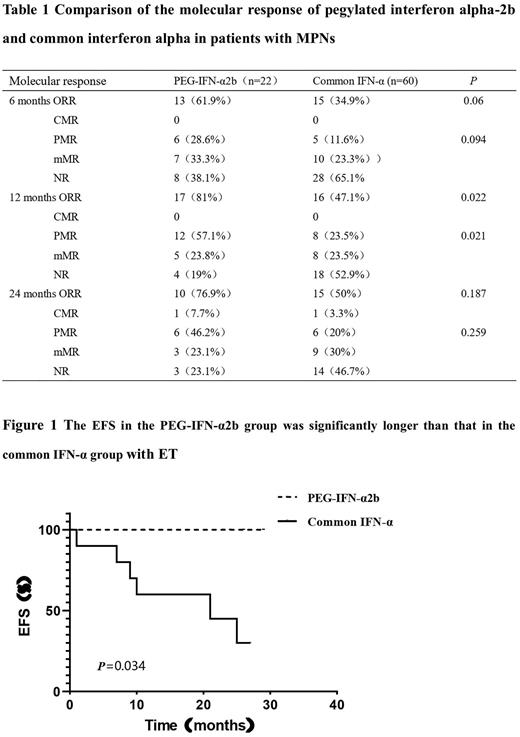Abstract
Objective: To compare the efficacy and safety of pegylated interferon alpha-2b (PEG-IFN-α2b) and common interferon alfa (IFN-α) in the treatment of myeloproliferative neoplasms (MPNs).
Methodology: This study was designed as a prospective clinical study. Patients with MPN who visited the Second Hospital of Tianjin Medical University from August 1, 2019 to June 30, 2022 were enrolled in this study. There were 30 patients in the PEG-IFN-α2b group and 60 patients in the common IFN-α group, and the median follow-up period was 24 (9 - 32) months. The differences in the clinical characteristics, efficacy and safety indicators between the two groups were compared.
Results: ①The baseline clinical characteristics of patients in the PEG-IFN-α2b group and the common IFN-α group were well balanced and comparable. ②Efficacy: There was no significant difference in hematological objective response rate (ORR) at month 6, 12 and 24 between the PEG-IFN-α2b group and the common IFN-α group (68.2% vs 60%, 86.4% vs 68.3%, 84.6% vs 68.3%, P > 0.05); the ORR of molecular response at month 12 in the PEG-IFN-α2b group was higher than that in the common IFN-α group (81% vs 47.1%, P = 0.022); the proportion of patients with decreased V617F%and scores for MPN-10 symptoms in the PEG-IFN-α2b group was significantly higher than that in the common IFN-α group (80% vs 46.4%, 82.4% vs 44.2%, P < 0.05); Interleukin-6 (IL-6), Tumor necrosis factor alpha (TNFα) and Interferon gamma (IFNγ) in the PEG-IFN-α2b group after treatment were significantly lower than those before treatment (P < 0.05); the event-free survival (EFS) in the PEG-IFN-α2b group tended to be longer than that in the common IFN-α2b group, and for patients with essential thrombocythemia (ET), the EFS in the PEG-IFN-α2b group was significantly longer than that in the common IFN-α group (P < 0.05). ③Safety: There was no significant difference in the incidence of hematological toxicity between the two groups, and the incidence of grade 3-4 adverse events of fever and influenza-like symptoms as non-hematological toxicity was significantly lower than that in the common IFN-α group (6.6% vs 23.3%, 6.6% vs 15%, P < 0.05).
Conclusion: Compared with common IFN-α group, PEG-IFN-α2b group showed significantly superior results for molecular response rate, V617F% reduction, physical symptoms improvement, and IL-6, TNFα and IFNγ reduction, as well as prolong EFS in ET patients with better safety profile.
Disclosures
No relevant conflicts of interest to declare.
Author notes
Asterisk with author names denotes non-ASH members.


This feature is available to Subscribers Only
Sign In or Create an Account Close Modal